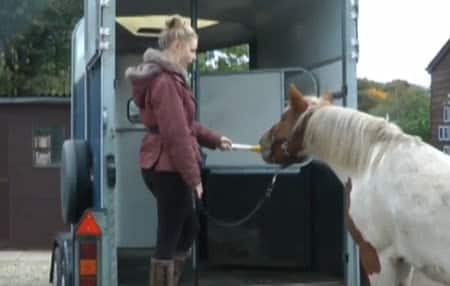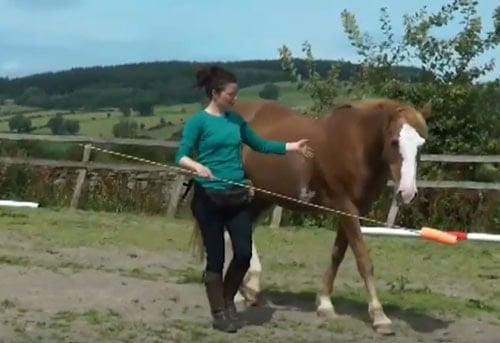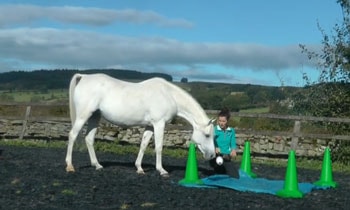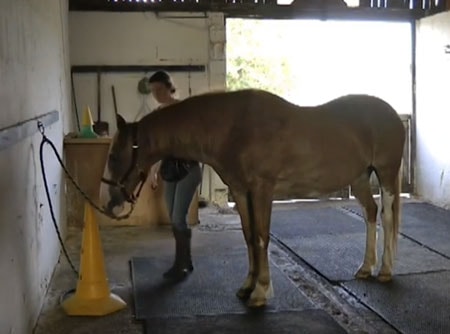Use Target Training to Load Your Horse onto the Trailer

She was asking her horse to “target” the end of a long training whip. The process was slow and calm and her horse’s confidence was increasing with each session. After just a few minutes, the horse was safely loaded and the women went happily on their way home…
In part 1 of this article series, you learned about getting started with clicker training. This valuable skill can be used to help your horse perfect his ground manners and build a stronger connection with you – his handler!
Now, it’s time to take things one step farther. Clicker training can be a valuable tool to teach your horses more advanced behaviors. For instance, your horse could learn better leading, ground work, lateral work – or best of all – to load calmly onto the horse trailer!
In this second article, we’ll look at the concepts of “target training” to help your horse follow more advanced commands. Once again, we’re going to share some techniques taught by horse trainer Hannah Weston of Connection Training. You can view her full video trainings on YouTube here.
The Three Types of Targeting
After you and your horse have mastered clicker training, you can start to incorporate targeting. It has many different uses including leading, loading, ground work, lateral work and even into riding under saddle.

Your chosen target just needs to be something that’s different from the regular things your horse interacts with. This way, they know for sure that you are asking for special behaviors.
Each of the three different targeting techniques helps you teach your horse slightly different behaviors.
1) Touching the Target – The simplest technique is to simply have your horse touch a target with his nose. Then, he receives a food reward for his effort. It’s a useful way to de-spook a horse or to get them to load onto a horse trailer.
2) Following a Target – With this method, you are having your horse follow a target as it is being held in front of them. This works best for moving behaviors like leading exercises, ground work and loading.
3) Stationary Target – The last method teaches your horse to stand quietly beside a target. This is best for stationary behaviors like tacking up, standing tied, or standing in the stall. It can also be used well when you’re riding to teach pole work, steering or forward motion.
Horses like the targeting training method because they begin to learn how they will be rewarded for each successful target. It makes them feel more confident and the training even becomes fun for them!
Think of targeting as a useful way to explain a behavior to your horse. Once the horse has had things explained to them, you can phase out the target and they will still understand how they should be acting.
When teaching your horse this technique, watch out for their emotional state. Aim for the right balance of relaxation and motivation.
Touch Targeting Exercises to Try
Teaching your horse to touch, follow, or stand by a target will help them learn manners and improve their confidence. Start by holding your target out to your horse so he can investigate. After a simple sniff, reward your horse with pats, some food, or a click just as you did with the foundational clicker training.
Over time, your horse will learn that interacting with the target is a good thing to do. They’ll want to do it so they can earn their reward.

For example, you might put a tarp on the ground. Then, ask your horse to touch your target as you stand near the scary object. Each time he touches the target and is rewarded, move the target a bit closer to the scary object.
Eventually, you can ask your horse to touch the scary object. With time, your horse will learn that a simple command of “touch” will let them investigate new objects and be rewarded at the same time. They get to investigate it and realize it’s not a threat.
Guide to Mounting Block - The target can be used as a guide to get your horse to walk up to the mounting block. Eventually, you’ll phase out use of the physical target and your horse will just know how to do this behavior.
Loading onto a Horse Trailer with Targeting - Touching a target can also be used to help your horse learn to load onto a horse trailer. Take your horse up to the trailer just to the point where they are starting to get uncomfortable. Then, bring out the target and ask your horse touch the target for a reward. Move one step up onto the trailer and ask your horse to again touch the target.
Just as it did with Stacey and Rachael’s horse, this technique lets the horse move upwards into the trailer. It gives them a chance to investigate the inside and everything becomes a little less scary.
Teach your Horse Lateral Flexions – Here, touch targeting tells your horse where to go as he reaches his head around to the side of his body. It’s a very clear way of explaining what you want from your horse. Again, you will gradually phase out the target and your horse will know to do this simply from cues from the lead line.
The Benefits of Following a Target
With this second type of targeting, you are rewarding your horse simply for following a target. They don’t actually need to touch anything. Sometimes horses need a specific “touch” target and a specific “follow” target. But you can try using the same one for both and see how your horse reacts.
Once your horse understands they need to follow the target, this can be a useful tool to teach lunging, turning, proper head carriage, collection, and even lateral work.
Using a Stationary Target to Teach Your Horse

One of the first ways you can use this is to teach your horse to stand quietly beside the cone. If your horse gets nervous in cross-ties or tied to a rail, the stationary target will help them learn to stand still while free. Slowly you can reintroduce the rope ties so they are able to stand quietly and safely.
Next, you can teach your movement by having them move towards a stationary target in the ring. For instance, a horse who doesn’t want to move forward will want to move towards a stationary target placed at the other end of the ring. This exercise will help them want to step out with more energy.
Here are a few practical ways to use stationary targets:
Learning to stand for injections – If you horse hates when the vet comes to call, you can use a stationary cone to teach them to stand quietly for injections.
Teach them to accept saddle pad and saddle – Your horse will associate standing at the stationary target with positive emotions.
Staying on the horse trailer once they’ve loaded – It’s a common problem for horses to want to immediately back off once they’ve walked onto a trailer. By placing a stationary target within the trailer, your horse will learn that it’s a good thing to stand quietly once they’ve walked in and reached their target. This technique empowers your horse and gives them a choice of what to do.
Teaching riding skills – Besides getting your horse to move forward as we described above, stationary targets can help with other riding skills. With a young horse, four cones set up in a square will give your horse constant stationary targets to aim for. You’ll reward them each time they reach a target. Gradually, this will let you teach them basic steering signals as you incorporate the reins.
Stationary targets can also be used to teach your horse to go over poles and jumps more confidently and calmly. This technique helps them stay more focused and forward over the obstacles without rushing.
We hope this article has given you a good idea of how this training technique could help your horse. If you’d like to learn more about how to actually apply these concepts to your own training, check out Hannah Weston of Connection Training.
If you’d like to learn more about how our SafeTack trailers make loading onto the trailer safer and easier, check out our articles here.

